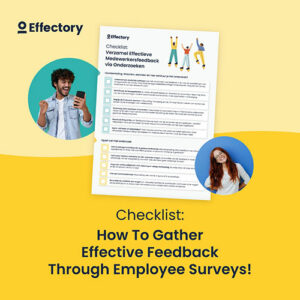Feedback has become an important tool in the work environment. It can boost productivity, help the company grow, and implement improvements to enhance the employee’s effectiveness along with the positive work experience. But, throughout the years, companies started applying different types of feedback, that it can be overwhelming for everyone involved, leading to feedback fatigue. Therefore, it is important to know what the differences are and how to request feedback in the most effective way.
Employee Feedback

Employee feedback definitions
There are two different types of employee feedback: the one given by employees and the ones they receive. At the end of the day, both is information that is shared formally and informally in relation to work experience, employee engagement, and satisfaction. Let’s look at it from the company perspective.
What is employee onboarding? The definitive Effectory guide
Received employee feedback is the information the company gets from the employee. This can be considered as the employee’s experience within the company, that determines their satisfaction with their individual roles, the team, management, and the company itself. In turn, this can affect their productivity, quality, and overall happiness at work.
Given employee feedback is the information given to the employee about their performance. This is the work experience coworkers share after working with them or the effect they have had on their manager, supervisor, teammates, and/or other departments. The feedback provided can contribute to improving the employee’s work ethic, collaboration, and relationships.
Soliciting feedback from employees: why is it important for business?
Both types of feedback are important as they can resolve any ongoing issues that either the company or the employee may or may not have been aware of. For instance, the employee may produce continuously stellar results but their individual attitude or approach to the role may make them appear as unapproachable, without their knowledge. This way, informing the employee that this could be the case, could help them open themselves up a little more and improve their experience as well as that of their peers.
In turn, this can also affect the feedback a company receives, as this feedback allows for the company to take a deep dive into individual experiences and address the wrongs and rights they may or may not have been aware of. As a company, be it management or staff, you do not have full oversight into every detailed experience. For instance, there might be a policy put in place that looks good on paper but applies differently in reality. This can help the company or management improve the employee’s experience, satisfaction, and engagement as well as their brand.
Report: Future of Employee Experience
Download this special report about The Future of Employee Experience, as published in The Times.
DownloadHow to ask employees for feedback?
Prior to conducting a survey, it is important you setup a plan. First, determine your objective: are you trying to simply collect information or are you looking to act on it as well? Has there been a sufficient time since the last survey to reflect upon the outcome of previous results?
Have you provided enough time for the action plan? Second, figure out what your listening needs are and what the context of the current situation is both internally and externally, ie. the current pandemic, can affect the setup of your survey as you do not want to add stress or discomfort to an already difficult situation. Finally, tailor your survey to the topic and mostly to your target audience.
Make sure to research beforehand if they are used to providing feedback. This can help you formulate your questions accordingly and decide upon the amount of questions you are going to ask them. For example, if your audience is not used to providing feedback, they may not provide you of the information you need if the questions are too open ended or too closed.
When conducting a survey, the phrasing of a question is pivotal when you are trying to gather results about a certain topic. It is important to ask validated questions. These are questions that have been researched and proven to be most effective.
For instance, positively charged questions are most helpful when gathering constructive feedback rather than simply have an employee answer “yes” or “no”. Try to phrase a question in a way that it can direct the employee to giving you insight into the data you need, especially regarding closed questions.
For example, try to ask “what is your number one suggestion to resolve this issue?” rather than “what are you unhappy about?” This can decrease the workload for the employer, who must decipher what information is useful, and consumes less time of the employee’s day.
It is also recommended to limit the total amount of questions and the questions per topic. An overall amount of 20-25 questions, with a time limit of 10-15 minutes, on a survey is more than enough.
When it comes to individual topics, it has been proven that the less questions you ask, the higher the response rate will be as you avoid survey fatigue. And finally, ensuring anonymity to retain privacy is considered as one of the best ways to request feedback as employees are less likely to be truthful if it can be traced back to them. This often originates out of fear of judgment or retaliation. In turn, it also provides the employees of a safe space, which can encourage them to be honest, which can only boost your results.
What should I avoid when requesting employee feedback?
Apart from overloading your employees with a large amount of questions and incorrect phrasing, there are a few other pitfalls you should avoid when conducting an employee feedback survey.
The first is to avoid conducting random surveys. If surveys are not conducted on a regular basis, such as monthly, quarterly or yearly, you may not be able to measure the outcome properly. In turn, this can also discourage employee participation as the timing may not be appropriate.
For instance, if the sales department are nearing the end of their quarter, they will not spend their time on a survey that was dropped into their mailbox unannounced because they are concerned about meeting their targets.
Another mistake to avoid is to have a survey that covers multiple topics, for instance requesting feedback on the manager, the team, and the company in the same survey. This will not adequately highlight the information you need nor will it present a proper reflection of any of the topics involved, as the information may get mixed up or the responsibility and ownership for improvement remains unclear.
After conducting a survey, try to avoid follow up meetings that requests more feedback from the employees. This may remove the promise of anonymity and leave the impression that their written feedback has not been taken into consideration. In addition, if the topic does not relate directly to the team, issues cannot be resolved on a team level.
When a survey targets a certain topic, the feedback should be clear and does not require further explanation.
And finally, allow sufficient time to implement your plan of action between surveys, depending on the topic. If a company survey is conducted on a monthly basis, three weeks may not be enough time to implement the required changes and record the outcome of your action plan. However, this may be enough time for a team-based survey to recur.
How to gather feedback from your employees
The definitive checklist for creating your employee engagement survey.
DownloadEmployee feedback methods
There are many different methods to request feedback from your employees. Below are a few examples, but not all of them need to be applied. At the end of the day, it is important to use what is most beneficial and efficient for your business.
– Recruitment feedback: This is feedback requested from interview candidates after they completed the full interview process. Even when a candidate has not been successful, they still may receive a survey to provide feedback on their recruiting process and interview experience. This can help a company improve the friendliness and efficiency of the overall procedure and determine the impression they leave on candidates.
– Onboarding: When new hires complete their onboarding process, it can be helpful to collect their feedback. Fresh faces can bring fresh perspectives, as they tend to be more excited and involved with the company while they learn about their new professional home. The feedback can relate to how friendly and efficient the onboarding process has been as well as their first impressions of the company.
– Employee satisfaction/engagement: this is usually gathered through a regular survey, consisting of many questions relating to different aspects of the company, that allows the employee to share their individual experience anonymously.
The benefits of employee engagement
– Exit survey: similarly, an exit survey can offer the employee an opportunity to vent or explain their reason for leaving. For example, this could relate to toxic company culture, bad management, lack of opportunities, or lack of wage increases. A departing employee is not necessarily caused due to negative company experience, their leave could be due to relocation or personal issues, but company experience plays a big part in employee retention.
Need more help on how to ask employees for feedback?
When requesting employee feedback, communicative and listening skills are the key. Here, at Effectory, we have setup several tools that your company can benefit from in relation to requesting and listening to feedback.
In addition, we also have a validated library that consists of 150 questions that have proven to be benchmarkable across the globe and can help you measure the data you are looking to collect.
This time saving option helps you build your survey quicker and decreases the chance of asking the wrong questions, as the questions in the library are specifically tailored and validated to request the information you need.
Bear in mind that there is no secret ingredient or recipe that can guarantee the success you may be looking for. While we provide an array of listening tools that you can benefit from, success is subjective as every company requires a different approach. Nevertheless, along with our specialized tools, our experts are here to help.
Book a free demo. See our solutions in action.
Effectory is Europe’s Leading provider of Employee Listening Solutions. Schedule a product demo and discover how to enhance your employees’ engagement.
Demo request

